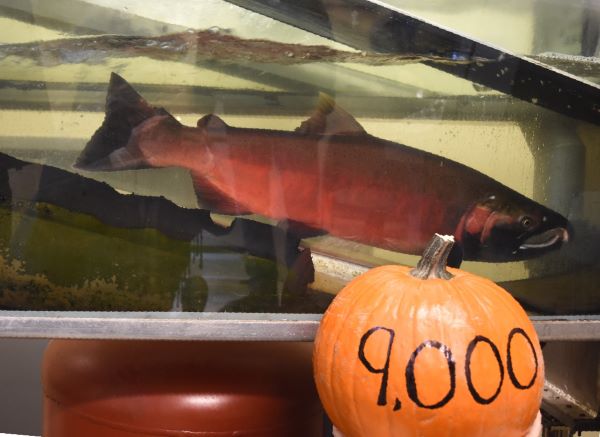
Mature coho develop a pronounced red color and kype (hooked beak) during spawning season.

Portland, Ore. (November 9, 2021) – Portland General Electric’s (PGE) Westside Hydropower Project on the Clackamas River is generating more than just reliable, emissions-free electricity – it’s also generating record-breaking returns of coho salmon. The number of adult, early run coho returning to the Upper Clackamas from the ocean just hit 9,000 fish, the largest seen at North Fork Dam since its construction and the start of data collection in 1958.
Early run coho, which typically pass upstream from September to October, are followed by a population of late-run fish that return from November to January. PGE’s fish biologists at the project attribute the early run’s success to investments in innovative fish passage infrastructure, which allow fish to bypass three dams safely and quickly. In particular, a new floating surface collector in North Fork Reservoir, which became operational in 2016, captures more than 90% of ocean-going juvenile fish in the reservoir. This facility is the only surface collection system in the region to bypass fish through a multi-dam complex utilizing a pipeline, without the aid of transport or trucking to a release site.
“Survival rates through the bypass pipeline are around 99%, and collection rates are among the highest in the region, if not the world,” explained Garth Wyatt, PGE senior fish biologist at the plant. “Using our new facilities, the time that it takes juvenile coho to pass the dams was reduced from as many as twelve days down to only two and half hours,” he added. This allows coho to arrive in the Lower Willamette River a bit earlier in the spring when water temperatures are cooler and predators are less active, increasing their odds of survival to the ocean. These survival gains, compounded by beneficial ocean conditions, have resulted in stronger adult returns and robust generations of young fish – starting the cycle over again.
“We’re thrilled to see our investments and science-based strategies paying off,” said Wyatt. While coho returns were strong throughout the Columbia River Basin in 2021, results on the Clackamas River have been breaking records with increasing frequency, at times diverging from poor region-wide trends. “We’ve observed record early run coho returns in four of the last eight years, all following infrastructure improvements,” he added.
Early run coho now represent the largest population of wild, ocean-going salmon in the Clackamas River Basin. Biologists expect this positive trend to continue, aided by collaborative habitat restoration projects, additional fish passage improvements and ongoing scientific research in the Clackamas River Basin.
Learn more about how PGE protects fish and wildlife while generating clean, reliable hydroelectricity on the Clackamas River.
B-roll video of coho arriving at North Fork Dam, identified and sorted by biologist Maggie David.

Mature coho develop a pronounced red color and kype (hooked beak) during spawning season.

P GE biologists celebrate the 9,000th coho with a festive Halloween pumpkin.